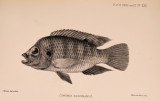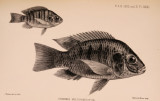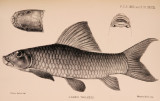| OCR Text |
Show 244 MR. R. SIIELFORD OX MIMETIC INSECTS AXD [Nov. 4, X X III. fig. 40, no. 17 in Table I.), with its swollen pedunculate posterior femora and white-tipped wings, resembles very closely the common little Dammar-bee Melipona vidua (Lepel.) (Plate X X III. fig. 41); it is remarkably active on the wing and has doubtless often been passed over by collectors, the least important of its foes. E. sarawakensis (IB) Wallace found crawling on timber, and stated " that they were remarkably ant-like " ; in this species the posterior femora are not swollen. Of the Tillomorphince, Clytellus westwoodi (20) and Halme clerifonnis (19) are almost indistinguishable from ants. X o t e s ox T a b l e I I.- Longicorns mimicking other Coleoptera. Excluding, for reasons already mentioned, the subfamilies Mesosince and Apomecynince, it will be seen that the Saperdince and Astatheince are essentially the mimetic subfamilies in this section. Most of the species are extremely common and highly conspicuous, and I have little doubt but that all are distasteful, and therefore furnish examples of synaposematic coloration (Mullerian mimicry). All the species of the genus Entelopes are mimetic. E. glauca (Guer.), red with black spots (Plate XXIII. fig. 32), is quite Coccinellid in appearance (compare fig. 30), though more by virtue of its markings than of its shape. This association of red colour with black spots is so typically a warning coloration, as exemplified by scores of species of Coccinellid*, that it is impossible to regard the same pattern on a Longicorn as anything but pseudaposematic or synaposematic. Entelopes n. sp. near wallacei (Pasc.), an entirely reddish-fulvous species, has as its model similarly coloured species of the family Galeru-cidae, Metrioidea apicalis (compare figs. 13 & 14, Plate XX.), which, as will be seen, serves also as model for two species of the Astatheince. Entelopes ioptera (Pasc.), with its yellow prothorax and blue elytra, and Entelopes amcena (Plate XX. fig. 26), with reddish prothorax and blue elytra, also find parallels amongst the distasteful Galerucidse (see the accompanying Table, pp. 242, 243 ; also Plate XX. fig. 25). Serixia modestci (Pasc.) and S. lychnura (Pasc.) are unlike any distasteful species with which I am acquainted ; the closely-allied S. prolata (Plate X X . fig. 12) and S. aurulenta (Pasc.) mimic a small reddish-fulvous Galerucid, jEnidia sp. (Plate XX. fig. 11). The genus Xyaste is interesting as it mimics beetles of quite a different nature-the Lycidse, whose distastefulness I have proved by repeated trials with various small mammals and birds. Xyaste is generically separated from Serixia by the thickened and pilose basal joints of the antenna?; the remaining joints, being of exceeding fineness, are more or less inconspicuous; and it is by this means that the thickened, flabellate, and short antennae of the Lycidae are simulated, whilst Ephies dilaticornis (Plate X X III. fig. 18) and Erythrus apicu-latus var. (Plate X X III. fig. 8), also mimetic of Lycidae, have the antennae shortened and dilated in almost the same manner as their |
































































































































































































































































































































